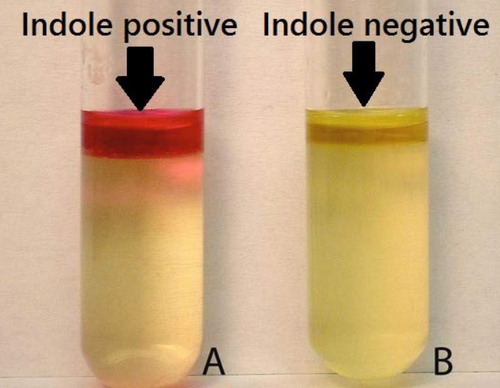IMViC Test
Last reviewed by Editorial Team on February 27th, 2019.
What is IMViC Test?
The IMViC Test is a procedure used to differentiate Family Enterobacteriaceae.
It consists of different biochemical test which stands for every letter in IMViC. These tests need to be carried out individually and its purpose is to identify members of the Enterobacteriaceae family. (1, 2)
-
I – Indole Test
-
M – Methyl Red Test
-
V – Voges-Proskauer Test
-
C – Citrate Utilization Test
Note: A small letter “I” is added for ease of reading.
IMViC Test Procedure
The test is performed individually and the procedure is based on the type of test being performed. We are going to tackle them one by one. (1, 2)

Image 1: The image shows an indole positive and indole negative test tubes.
Picture Source: microbiologyinfo.com
#1- Indole Test
Aim: To track the production of indole from amino acid tryptophan degradation.
This particular test can be performed on three different mediums:
- Sulfide-indole-motility (SIM)
- Tryptophan broth
- Motility urease indole (MIU) (2, 3)
Procedure:
- A loopful of bacteria is inoculated into the tryptone broth.
- It will be incubated for 48 hours.
- To detect indole, a reagent should be added; Kovac’s reagent/Indole reagent. (3, 4, 5)
Significance
- It differentiates E. coli from other forms of enteric bacteria.
- It differentiates Proteus mirabilis from other Proteus species. (3, 4)
Interpretation
A clear broth simply means that an organism didn’t grow and cannot be tested. A Kovac’s agent is added to the medium and results are interpreted.
A positive result has a red layer at the top. A negative result has a yellow or brown layer.
- Positive result – There will be a red layer at the top of the tube after adding Kovac’s reagent.
- Negative result – A yellow or brown layer is noticeable after adding the reagent. (4, 5, 6)
#2 – Methyl Red (MR) Test

Picture 2: The image shows the two possible results of methyl red test.
Photo Source: microbiologyinfo.com
Aim: To check for the production of acids during sugar formation.
Procedure
- Inoculate a loopful of bacteria into the MRVP broth.
- Incubate it for about three to five days. (5, 6)
Interpretation
The broth must be turbid after the incubation period. Add about 3 to 4 drops of methyl red to the broth. Make sure you do not shake the tube. Result interpretations are as follows:
- Positive result – A red color is noticeable at the top of the broth after the addition of methyl red reagent.
- Negative result – A yellow layer is noticeable after adding methyl red reagent. (5, 6, 7)
#3 – Voges-Proskauer (VP) Test

Photo 3: The image shows the results of Voges-Proskauer (VP) Test.
Image Source: i0.wp.com/microbeonline.com
Aim: To check for the presence of acetoin (acetyl methyl carbinol) from glucose.
Procedure
- An MRVP broth is used to inoculate a loopful of bacteria.
- It should be incubated for about three to five days.
- Add the reagents to the broth (VP A and VP B).
- Shake well and wait for a few minutes. (7, 8)
Description
Those organisms that test negative for methyl red test produce butanediol; non-acid products that do not lower the pH level. Examples are Enterobacter, Serratia and some species of Bacillus.
Interpretation
A good turbidity should be present before reading the Voges-Proskauer test. If the broth is clear, it signals that no organisms grow in the medium and it cannot be tested. Interpretations are as follows:
- Positive result – A red-brown or pink color is noticeable after adding reagents. It confirms the presence of acetoin.
- Negative result – No significant change in color after adding the reagent. It might also change the color into copper. (6, 7, 8)
#4 – Citrate Utilization Test

Image 4: Positive and negative results for citrate utilization test.
Picture Source: www.researchgate.net
Aim: To check the organism’s ability to utilize citrate.
Procedure
- Inoculate a loopful of bacteria onto the citrate agar slant.
- Incubate for about 24 to 48 hours.
- If you are testing a Bacillus species, you need to incubate for a long period of time.
- Make sure the cap is loose during the incubation period. (7, 8, 9)
Description
This procedure is used to test the ability of an organism to use citrate as a source of carbon. It comes with a pH indicator (bromthymol blue).
The citrate utilization test uses Simmons citrate agar. Results are as follows:
- Positive result – There will be noticeable growth and color change (a slant with a Prussian blue color) discoloration in the tube.
- Negative result – Lack of growth and color change in the test tube.
The IMViC test is performed to know the physiologic characteristics of certain types of bacteria particularly the ones that belong to the family of Enterobacteriaceae such as the Escherichia and Enterobacter.
It consists of four definitive tests which are used to differentiate Gram-negative and Gram-positive bacteria particularly Escherichia coli and the Enterobacter – Klebsiella group (coliform bacteria). (4, 7, 9, 10)
References:
- https://microbeonline.com/imvic-tests-principle-procedure-and-results/
- https://en.wikipedia.org/wiki/IMViC
- http://www.austincc.edu/microbugz/imvic.php
- https://biocyclopedia.com/index/biotechnology_methods/microbiology/imvic_test.php
- https://www.generalmicroscience.com/microbial-laboratory-techniques/imvic-biochemical-test-performed/
- http://spot.pcc.edu/~jvolpe/b/bi234/lab/differentialMedia/imvic2.htm
- https://www.ncbi.nlm.nih.gov/pmc/articles/PMC242642/
- https://pdfs.semanticscholar.org/c337/57cf11e9bf24cce9e4a29a69521e21c877a9.pdf
- https://thevirtualedge.weebly.com/imvic-test.html
- http://abt.ucpress.edu/content/54/2/112
Similar Posts:
- Methyl Red Test
- Indole Test
- Oxidase Test
- Benedict’s Test
- What is Gram Stain Test – Staining Procedure, Principle and Results
